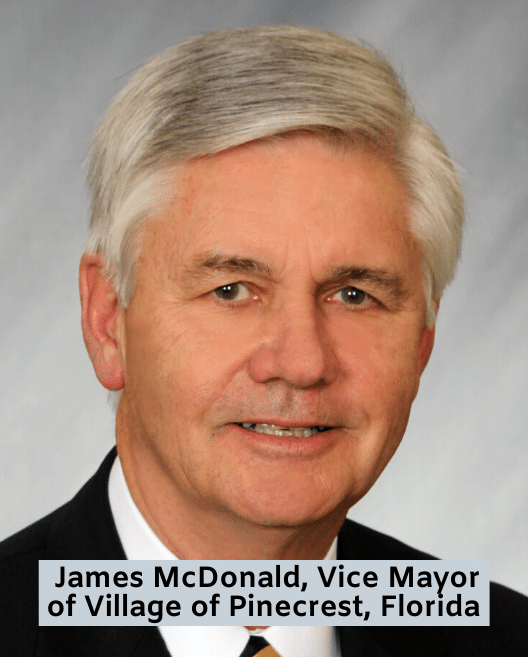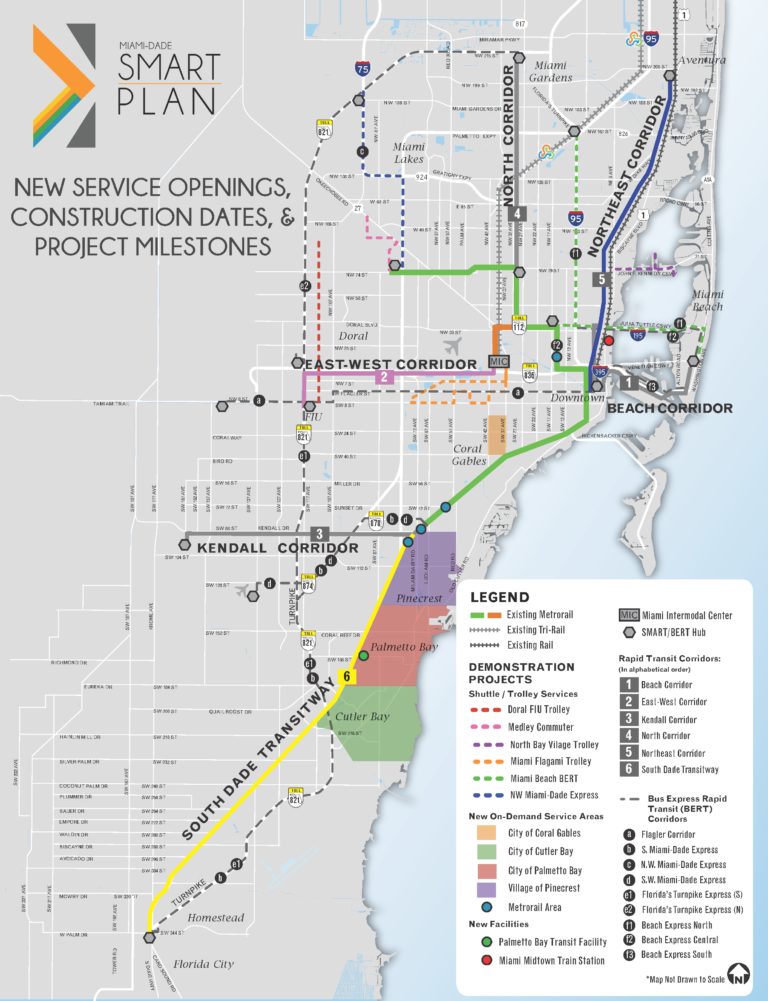AMERICANS FOR TRANSPORTATION MOBILITY COALITION (ATM)
Written by Debra Zimmerman Murphey
Originally posted in FasterBetterSafer
Part One of a Two-Part Series
It’s a fall afternoon and Village of Pinecrest Vice Mayor and long-time Florida resident James McDonald is talking infrastructure in Miami-Dade County. The county has a population of 2.75 million and is part of the greater Miami region — among the largest metropolitan areas in the Southeastern United States and one with growing traffic gridlock.
“Our biggest focus in Miami-Dade is expanding our transit system. The county is moving forward with a gold-standard Bus Rapid Transit (BRT), and this will be a game-changer and spur economic development,” McDonald says, adding that residents and visitors in South Florida need connectivity that goes beyond the automobile.
However, old habits may die hard. The 2013-2017 American Community Survey showed that, “Driving alone remained the top choice for Miami-Dade County commuters. Over the last ten years, their number grew to 91.2 percent of workers from 78.2 percent in 2008. Public transportation remained unchanged at 5.6 percent, while those working at home grew from 4 percent to 7.1 percent. The average travel time to work grew from 29.6 minutes to 32.7 minutes.” (Source: Miami-Dade County)
As slower mobility mushrooms throughout the nation, McDonald is part of a widening universe of Americans and community leaders and officials strategically working to transform overburdened infrastructure. This includes a commitment to a broad multimodal system, in some cases buoyed by public transit, that can help meet capacity needs and decrease commute times.
 “Transportation is regional and I’ve seen it here and around the country,” says McDonald. “Whether a rider goes from a local bus system to, let’s say, a large Metrorail system or to a larger regional rail system, what we are doing here is looking at how we integrate the various modes of public transportation because that’s what people want. They don’t want to be sitting in their cars for hours and hours. We went through that after World War II and all of our transit and trolleys went away and everything was the generation of cars.”
“Transportation is regional and I’ve seen it here and around the country,” says McDonald. “Whether a rider goes from a local bus system to, let’s say, a large Metrorail system or to a larger regional rail system, what we are doing here is looking at how we integrate the various modes of public transportation because that’s what people want. They don’t want to be sitting in their cars for hours and hours. We went through that after World War II and all of our transit and trolleys went away and everything was the generation of cars.”
In September 2019, Oliver Gilbert III, Mayor of the City of Miami Gardens and Chairman of the Miami-Dade Transportation Planning Organization (TPO), testified before a United States House of Representatives’ Highways and Transit Subcommittee on “Pricing and Technology Strategies to Address Congestion on and Financing of America’s Roads.”
“We need a federal funding process that acknowledges the need of a community to access opportunity within a reasonable timeframe so all the partners can plan and do their part,” he said. “There needs to be predefined funding structures for regions like Miami–Dade that provides for more than widening highways as a solution to congestion.”
In Miami-Dade County, one of three counties that comprise the teeming Miami metropolitan region, the interstate system, heavily traveled expressways, electronic toll lanes and express buses provide a matrix of connectivity, but the cost of better infrastructure, streamlining public transit to propel ridership, and the need for federal support are foremost.
In his testimony, Gilbert asked for $100 million in funding from the Federal Transit Administration (FTA) for the area’s Strategic Miami Area Rapid Transit (SMART) Plan, explaining that local funding for these projects has been committed over the next 40 years.
“Traffic is an impediment not just to our growth economically but to our development as a community,” Gilbert said. “Our Expressway System has almost reached its limit, and we have no room to build our way out of congestion. This is why we are providing travel choices and alternatives that include both Express Lanes as well as expanding transit through the Miami-Dade SMART Plan, a rapid transit plan for our future.”
Reimagining Transportation: This is Not Your Grandmother’s Bus 
The first leg of the new Miami-Dade County BRT will be a converted South Dade TransitWay (already a dedicated bus lane) to a 20-mile route, with rail-like travel time, upgraded stations, smart signals and pre-paid fares, that will eventually sync with elevated rail.
That corridor is currently in the development and funding stages. The price-tag will be $300 million — a cost that will be split between an anticipated federal grant and state and county funding. (It runs from the Dadeland South Metrorail Station to the SW 344th Street Park-and-Ride/Transit Terminal and provides a mobility link between the Miami Central Business District and the Village of Pinecrest, the Village of Palmetto Bay, Town of Cutler Bay, City of Homestead, and Florida City.)
“It’s important for all of us. Transportation — being able to get around — is critically important,” McDonald says. “We have a number of universities in this town. … We’ve got a huge educational infrastructure down here and the students who are traveling are also contributing to the traffic congestion. It’s important for this community to develop our transit and improve our bus system, and marry the two.”
McDonald emphasizes that, “Every corridor is different and one size does not fit all. You have to look at what your issue is, and what is the best way to deal with it.” He recognizes nearby communities that need economic drivers and the younger generations’ transportation and quality-of-life concerns, in addition to the needs of his constituents in upscale and large-lot Village of Pinecrest, a suburb outside of Miami.
South Florida’s leaders know that the state’s transportation system must meet a range of public and demographic demands, and they are cognizant that roads and vehicles may not always be the answer. McDonald shared that his 32-year-old son, an architect, used to don a helmet to ride an electric skateboard part of the way to work, but safety was a concern.
Who would have thought about skateboards — or Segways, bike-shares, autonomous vehicles or hip technology-integrated faster buses — decades ago? Polling shows Millennials aren’t crazy about being beholden to a car and that on the other end of the age spectrum, senior citizens need and want transportation options.
All of these matters should be addressed by the White House and Congress in promised infrastructure legislation and current policies.
View original post on FasterBetterSafer
About the Americans for Transportation Mobility Coalition (ATM)
www.fasterbettersafer.org
The Americans for Transportation Mobility (ATM) Coalition formed in 2001. It brings together businesses, the labor and union sectors, transportation stakeholders, and the public to advocate a robust transportation infrastructure grid in the United States. This includes promoting ongoing and sustainable funding through policies and broad-based initiatives.
Tags: Americans for Transportation Mobility Coalition, ATM, ATM Coalition, Debra Zimmerman Murphey, FasterBetterSafer, James McDonald, Miami-Dade County, Miami-Dade County BRT, Smart, Strategic Miami Area Rapid Transit Plan






 RSS Feed
RSS Feed